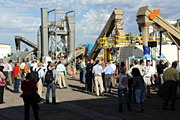- Number 348 |
- October 17, 2011
Helping industrialize biomass

Biomass feedstock.
Many envision a day when raw materials such as wood chips and corn stalks are transformed into a high-quality commodity traded on the open market beside grain, coal and crude oil.
Scientists already know how to convert grass, stalks and straw into biofuels, but numerous challenges remain to develop biomass into an industrial-scale commodity that can significantly contribute to the nation’s fuel needs. That’s why the DOE's Idaho National Laboratory recently hosted a workshop with government, university and industry partners to forge a path forward.
Roughly 100 workshop participants convened at INL to discuss technical challenges and learn how DOE’s new Feedstock Process Demonstration Unit (PDU) at INL enables research partners to produce large quantities of test materials for bioenergy producers.
The processes for transforming raw biomass into high-quality feedstocks — preconversion, formulation and densification — aren’t unlike the steps required for converting wheat to flour and then to bread.
Just as wheat is ground into flour before it arrives in the baker’s kitchen, preconversion is the mechanical, thermal or chemical breakdown of raw biomass. Formulation is akin to combining the ingredients of a bread recipe — different types of biomass may be mixed together or with other ingredients that improve stability or energy production. Finally, densification is the use of temperature and pressure to set and bind the ingredients together similar to the way an oven bakes bread.
All three steps are key to providing bioenergy producers with feedstocks of sufficient quality, quantity and stability. To this end, the PDU based at INL accommodates large-scale testing of new approaches.
For example, researchers can test ideas conceived in the lab by producing large quantities of feedstock so bioenergy producers can assess new recipes. Academic or industry researchers can also collect processing data for whatever approach they’re studying. The PDU currently includes coarse and fine grinders, a drier, a pellet mill and means for collecting data about particle flow rates, power consumption and other factors.
The PDU now provides a means to take laboratory-scale ideas and work with bioenergy producers to test them. Although biofuels PDUs also exist at other national labs, INL’s is the only one that focuses on feedstock supply and logistics.[Nicole Stricker, 208.526.5955,
nicole.stricker@inl.gov]
